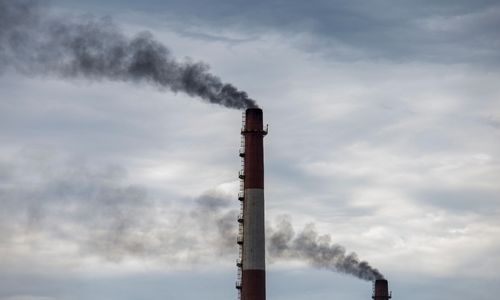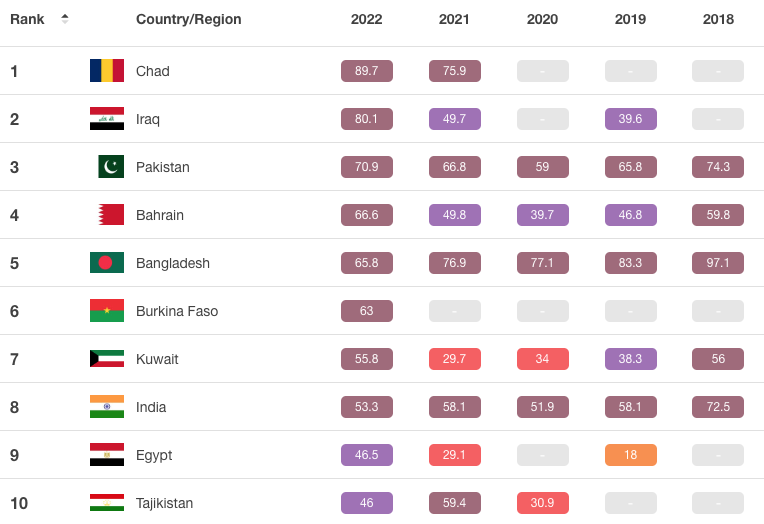IQAir ranks Bahrain among most polluted for air quality in 2022
TDT | Manama
The Daily Tribune – www.newsofbahrain.com
Bahrain is among the top five most polluted countries in 2022 for air quality, alongside Chad, Iraq, Pakistan, and Bangladesh, according to a report from Swiss air quality technology company IQAir.
The report finds that Bahrain’s air concentration level of 66.6 micrograms per cubic meter (mcg/m3) in 2022 is 13 times higher than the WHO PM2.5 annual guideline.
It means that for every cubic meter of air, there are 66.6 micrograms of lung-damaging airborne particles known as PM 2.5.
Research shows that exposure to such particulate matter can lead to heart attacks, asthma attacks, and premature death.
Studies have also linked longterm exposure to PM 2.5 with a higher death rate from Covid-19.
The sources of pollution are sandstorms, industrial emissions, private vehicle usage, and fertilizer manufacturing.
When the WHO first published air quality guidelines in 2005, it said the acceptable levels of air pollution were less than 10 micrograms per cubic meter.
In 2021, the WHO changed its benchmark guidelines to below five micrograms per cubic meter.
In 2021, the same study also picked Bahrain as among the ten nations having the worst air quality.
Situation yesterday
So, The Daily Tribune went on and checked IQAir’s website to find out the situation yesterday.
Our search showed that yesterday, in Manama, PM2.5 concentration was 22.1 mcg/m3, which is 4.4 times the WHO annual air quality guideline value.
The report also states that the worst month to breathe in Bahrain was July, with PM2.5 concentration hitting 51.6 mcg/m³.
From February through until the end of November, the air quality was “Unhealthy for sensitive groups” with figures between 35.5 and 55.4 µg/m³.
The remaining months of December and January saw the best air quality, with figures between 12.1 and 35.4 mcg/m³, even though it was of “Moderate” quality.
Bahrain not alone!
Bahrain was not alone among the Gulf Cooperation Council nations when it comes to deteriorating air quality standards.
Following Bahrain on the IQAir ranking from GCC was Kuwait at the 7th spot with 55.8 mcg/ m3, the United Arab Emirates at 11th with 45.9mcg/m3, Qatar at 14th with 42.5µg/m3, and Saudi Arabia at 15th with 41.5mcg/ m3.
The worst, however, is Chad with 89.7 mcg/m3 (17 times higher), Iraq at 80.1 mcg/m3 (14 times higher), Pakistan at 70.9 mcg/m3 (14 times higher), and Bangladesh at 65.8 mcg/m3 (13 times higher than the WHO PM2.5 annual guideline).
For this report, scientists analyzed data from more than 30,000 air quality monitoring stations across 7,323 locations in 131 countries, territories, and regions.
Can we do something about it?
Yes, says the report, highlighting the steps taken to conserve energy through several initiatives, such as promoting the trend towards green energy, policies to reduce consumption, and enhancing the utilization of natural resources.
Only six met WHO limits
Only six countries met the WHO’s updated health limits: Australia, Estonia, Finland, Grenada, Iceland, and New Zealand, the report said.
The most polluted cities globally were Lahore, Pakistan; Hotan, China; Bhiwadi, India; Delhi, India; and Peshawar, Pakistan.
The damning report also highlights that about 90% of the global population experiencing unhealthy air quality in 2022.
The report also said that India and Pakistan endured the worst air quality in the Central and South Asian region, where more than half of the population resides in areas with PM 2.5 particle concentrations about seven times higher than WHO’s suggested levels.
In the US, the most polluted cities were Columbus, Ohio, followed by Atlanta, Chicago, Indianapolis, and Dallas.
Air quality in Columbus hit 13.1 micrograms of PM 2.5 particles per cubic meter in 2022, making it the most polluted major city in the US.
In 2021, this report included data from 6,475 locations in 117 countries, territories, and regions.
In 2022, these numbers have increased to 7,323 locations in 131 countries, territories, and regions.
Related Posts


